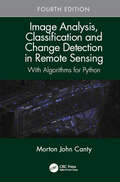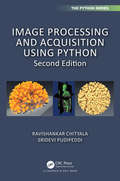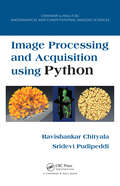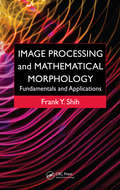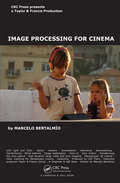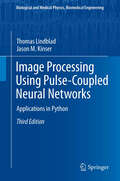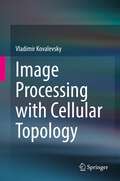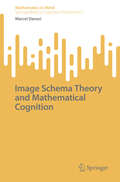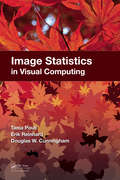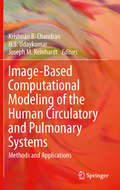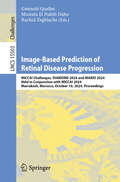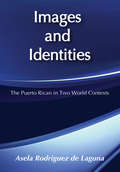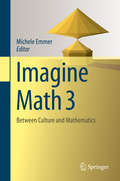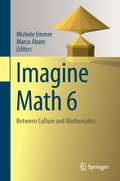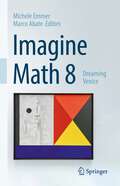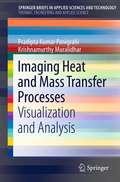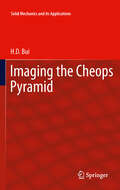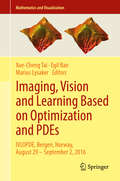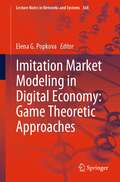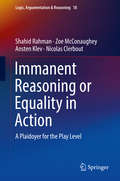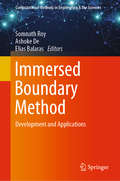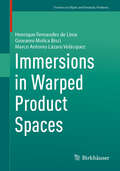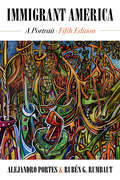- Table View
- List View
Image Analysis, Classification and Change Detection in Remote Sensing: With Algorithms for Python, Fourth Edition
by Morton John CantyImage Analysis, Classification and Change Detection in Remote Sensing: With Algorithms for Python, Fourth Edition, is focused on the development and implementation of statistically motivated, data-driven techniques for digital image analysis of remotely sensed imagery and it features a tight interweaving of statistical and machine learning theory of algorithms with computer codes. It develops statistical methods for the analysis of optical/infrared and synthetic aperture radar (SAR) imagery, including wavelet transformations, kernel methods for nonlinear classification, as well as an introduction to deep learning in the context of feed forward neural networks. New in the Fourth Edition: An in-depth treatment of a recent sequential change detection algorithm for polarimetric SAR image time series. The accompanying software consists of Python (open source) versions of all of the main image analysis algorithms. Presents easy, platform-independent software installation methods (Docker containerization). Utilizes freely accessible imagery via the Google Earth Engine and provides many examples of cloud programming (Google Earth Engine API). Examines deep learning examples including TensorFlow and a sound introduction to neural networks, Based on the success and the reputation of the previous editions and compared to other textbooks in the market, Professor Canty’s fourth edition differs in the depth and sophistication of the material treated as well as in its consistent use of computer codes to illustrate the methods and algorithms discussed. It is self-contained and illustrated with many programming examples, all of which can be conveniently run in a web browser. Each chapter concludes with exercises complementing or extending the material in the text.
Image Operators: Image Processing in Python
by Jason M. KinserFor decades, researchers have been developing algorithms to manipulate and analyze images. From this, a common set of image tools now appear in many high-level programming languages. Consequently, the amount of coding required by a user has significantly lessened over the years. While the libraries for image analysis are coalescing to a common toolkit, the language of image analysis has remained stagnant. Often, textual descriptions of an analytical protocol consume far more real estate than does the computer code required to execute the processes. Furthermore, the textual explanations are sometimes vague or incomplete. This book offers a precise mathematical language for the field of image processing. Defined operators correspond directly to standard library routines, greatly facilitating the translation between mathematical descriptions and computer script. This text is presented with Python 3 examples. This text will provide a unified language for image processing Provides the theoretical foundations with accompanied Python® scripts to precisely describe steps in image processing applications Linkage between scripts and theory through operators will be presented All chapters will contain theories, operator equivalents, examples, Python® codes, and exercises
Image Processing and Acquisition using Python (Chapman & Hall/CRC The Python Series)
by Ravishankar Chityala Sridevi PudipeddiImage Processing and Acquisition using Python provides readers with a sound foundation in both image acquisition and image processing—one of the first books to integrate these topics together. By improving readers’ knowledge of image acquisition techniques and corresponding image processing, the book will help them perform experiments more effectively and cost efficiently as well as analyze and measure more accurately. Long recognized as one of the easiest languages for non-programmers to learn, Python is used in a variety of practical examples. A refresher for more experienced readers, the first part of the book presents an introduction to Python, Python modules, reading and writing images using Python, and an introduction to images. The second part discusses the basics of image processing, including pre/post processing using filters, segmentation, morphological operations, and measurements. The second part describes image acquisition using various modalities, such as x-ray, CT, MRI, light microscopy, and electron microscopy. These modalities encompass most of the common image acquisition methods currently used by researchers in academia and industry. Features Covers both the physical methods of obtaining images and the analytical processing methods required to understand the science behind the images. Contains many examples, detailed derivations, and working Python examples of the techniques. Offers practical tips on image acquisition and processing. Includes numerous exercises to test the reader’s skills in Python programming and image processing, with solutions to selected problems, example programs, and images available on the book’s web page. New to this edition Machine learning has become an indispensable part of image processing and computer vision, so in this new edition two new chapters are included: one on neural networks and the other on convolutional neural networks. A new chapter on affine transform and many new algorithms. Updated Python code aligned to the latest version of modules.
Image Processing and Acquisition using Python (Chapman And Hall/crc Mathematical And Computational Imaging Sciences Ser.)
by Ravishankar Chityala Sridevi PudipeddiImage Processing and Acquisition using Python provides readers with a sound foundation in both image acquisition and image processing-one of the first books to integrate these topics together. By improving readers' knowledge of image acquisition techniques and corresponding image processing, the book will help them perform experiments more effectiv
Image Processing and Mathematical Morphology: Fundamentals and Applications
by Frank Y. ShihIn the development of digital multimedia, the importance and impact of image processing and mathematical morphology are well documented in areas ranging from automated vision detection and inspection to object recognition, image analysis and pattern recognition. Those working in these ever-evolving fields require a solid grasp of basic fundamentals, theory, and related applications—and few books can provide the unique tools for learning contained in this text. Image Processing and Mathematical Morphology: Fundamentals and Applications is a comprehensive, wide-ranging overview of morphological mechanisms and techniques and their relation to image processing. More than merely a tutorial on vital technical information, the book places this knowledge into a theoretical framework. This helps readers analyze key principles and architectures and then use the author’s novel ideas on implementation of advanced algorithms to formulate a practical and detailed plan to develop and foster their own ideas. The book: Presents the history and state-of-the-art techniques related to image morphological processing, with numerous practical examples Gives readers a clear tutorial on complex technology and other tools that rely on their intuition for a clear understanding of the subject Includes an updated bibliography and useful graphs and illustrations Examines several new algorithms in great detail so that readers can adapt them to derive their own solution approaches This invaluable reference helps readers assess and simplify problems and their essential requirements and complexities, giving them all the necessary data and methodology to master current theoretical developments and applications, as well as create new ones.
Image Processing for Cinema (Chapman & Hall/CRC Mathematical and Computational Imaging Sciences Series)
by Marcelo BertalmioImage Processing for Cinema presents a detailed overview of image processing techniques that are used in practice in digital cinema. The book shows how image processing has become ubiquitous in movie-making, from shooting to exhibition. It covers all the ways in which image processing algorithms are used to enhance, restore, adapt, and convert movi
Image Processing using Pulse-Coupled Neural Networks: Applications in Python
by Thomas Lindblad Jason M. KinserImage processing algorithms based on the mammalian visual cortex are powerful tools for extraction information and manipulating images. This book reviews the neural theory and translates them into digital models. Applications are given in areas of image recognition, foveation, image fusion and information extraction. The third edition reflects renewed international interest in pulse image processing with updated sections presenting several newly developed applications. This edition also introduces a suite of Python scripts that assist readers in replicating results presented in the text and to further develop their own applications.
Image Processing with Cellular Topology
by Vladimir KovalevskyThis book explains why the finite topological space known as abstract cell complex is important for successful image processing and presents image processing methods based on abstract cell complex, especially for tracing and encoding of boundaries of homogeneous regions. Many examples are provided in the book, some teach you how to trace and encode boundaries in binary, indexed and colour images. Other examples explain how to encode a boundary as a sequence of straight-line segments which is important for shape recognition. A new method of edge detection in two- and three-dimensional images is suggested. Also, a discussion problem is included in the book: A derivative is defined as the limit of the relation of the increment of the function to the increment of the argument as the latter tends to zero. Is it not better to estimate derivatives as the relation of the increment of the function to the optimal increment of the argument instead of taking exceedingly small increment which leads to errors? This book addresses all above questions and provide the answers.
Image Schema Theory and Mathematical Cognition (Mathematics in Mind)
by Marcel DanesiThis book uses blending theory in math cognition, and assesses the main aspect of this theory, called image schema theory. Applied work in math pedagogy has used this theory, but no work has assessed its validity. This book provides an overall assessment of the theory with regard to its validity in the study of math cognition. Overall, this book presents image schema theory as it has evolved today to mathematicians, cognitive scientists, and math educators, deriving from it any concrete implications for modeling math in computer science and, on the other side, for making math pedagogy more effective.
Image Statistics in Visual Computing
by Tania Pouli Erik Reinhard Douglas W. CunninghamTo achieve the complex task of interpreting what we see, our brains rely on statistical regularities and patterns in visual data. Knowledge of these regularities can also be considerably useful in visual computing disciplines, such as computer vision, computer graphics, and image processing. The field of natural image statistics studies the regular
Image-Based Computational Modeling of the Human Circulatory and Pulmonary Systems
by Krishnan B. Chandran Joseph M. Reinhardt H. S. UdaykumarImage-Based Computational Modeling of the Human Circulatory and Pulmonary Systems provides an overview of the current modeling methods and applications enhancing interventional treatments and computer-aided surgery. A detailed description of the techniques behind image acquisition, processing and three-dimensional reconstruction are included. Techniques for the computational simulation of solid and fluid mechanics and structure interaction are also discussed, in addition to various cardiovascular and pulmonary applications. Engineers and researchers involved with image processing and computational modeling of human organ systems will find this a valuable reference.
Image-Based Prediction of Retinal Disease Progression: MICCAI Challenges, DIAMOND 2024 and MARIO 2024, Held in Conjunction with MICCAI 2024, Marrakesh, Morocco, October 10, 2024, Proceedings (Lecture Notes in Computer Science #15503)
by Gwenolé Quellec Mostafa El Habib Daho Rachid ZeghlacheThis book constitutes the proceedings from the MICCAI Challenges, Device-Independent Diabetic Macular Edema Onset Prediction, DIAMOND 2024, and Monitoring Age-Related macular degeneration progression in Optical coherence tomography, MARIO 2024, held in conjunction with the 27th International conference on Medical Image Computing and Computer Assisted Intervention, MICCAI 2024, in Marrakesh, Morocco in October 2024. The 15 papers included in this book from MARIO 2024 were carefully reviewed and selected from 17 submissions, whereas the 6 papers included here from DIAMOND 2024 were carefully reviewed and selected from 8 submissions. These papers focus on a wide range of state-of-the-art deep learning approaches to derive patient specific rules for Diabetic retinopathy (DR) and age-related macular degeneration (AMD) progression prediction from retinal images.
Images and Identities: Puerto Rican in Two World Contexts
by Asela Rodriguez LagunaFirst published in 1987. Routledge is an imprint of Taylor & Francis.
Imagine Math
by Michele EmmerImagine mathematics, imagine with the help of mathematics, imagine new worlds, new geometries, new forms. This book is intended to contribute to grasping how much that is interesting and new is happening in the relationships between mathematics, imagination and culture. With a look at the past, at figures and events, that help to understand the phenomena of today. It is no coincidence that this volume contains an homage to the great Italian artist of the 1700s, Andrea Pozzo, and his perspective views. Theatre, art and architecture are the topics of choice, along with music, literature and cinema. No less important are applications of mathematics to medicine and economics. The treatment is rigorous but captivating, detailed but full of evocations, an all-embracing look at the world of mathematics and culture
Imagine Math 6: Between Culture And Mathematics
by Michele Emmer Marco AbateImagine mathematics, imagine with the help of mathematics, imagine new worlds, new geometries, new forms. Imagine building mathematical models that make it possible to manage our world better, imagine combining music, art, poetry, literature, architecture and cinema with mathematics. Imagine the unpredictable and sometimes counterintuitive applications of mathematics in all areas of human endeavour. Imagination and mathematics, imagination and culture, culture and mathematics.This sixth volume in the series begins with a homage to the architect Zaha Hadid, who died on March 31st, 2016, a few weeks before the opening of a large exhibition of her works in Palazzo Franchetti in Venice, where all the Mathematics and Culture conferences have taken place in the last years. A large section of the book is dedicated to literature, narrative and mathematics including a contribution from Simon Singh. It discusses the role of media in mathematics, including museums of science, journals and movies. Mathematics and applications, including blood circulation and preventing crimes using earthquakes, is also addressed, while a section on mathematics and art examines the role of math in design. A large selection presents photos of mathematicians and mathematical objects by Vincent Moncorge. Discussing all topics in a way that is rigorous but captivating, detailed but full of evocations, it offers an all-embracing look at the world of mathematics and culture.
Imagine Math 8: Dreaming Venice
by Michele Emmer Marco AbateThis eighth volume of Imagine Math is different from all the previous ones. The reason is very clear: in the last two years, the world changed, and we still do not know what the world of tomorrow will look like. Difficult to make predictions. This volume has a subtitle Dreaming Venice. Venice, the dream city of dreams, that miraculous image of a city on water that resisted for hundreds of years, has become in the last two years truly unreachable. Many things tie this book to the previous ones. Once again, this volume also starts like Imagine Math 7, with a homage to the Italian artist Mimmo Paladino who created exclusively for the Imagine Math 8 volume a new series of ten original and unique works of art dedicated to Piero della Francesca. Many artists, art historians, designers and musicians are involved in the new book, including Linda D. Henderson and Marco Pierini, Claudio Ambrosini and Davide Amodio. Space also for comics and mathematics in a Disney key. Many applications, from Origami to mathematical models for world hunger. Particular attention to classical and modern architecture, with Tullia Iori.As usual, the topics are treated in a way that is rigorous but captivating, detailed and full of evocations. This is an all-embracing look at the world of mathematics and culture.
Imaging Heat and Mass Transfer Processes
by Krishnamurthy Muralidhar Pradipta Kumar PanigrahiImaging Heat and Mass Transfer Processes: Visualization and Analysis applies Schlieren and shadowgraph techniques to complex heat and mass transfer processes. Several applications are considered where thermal and concentration fields play a central role. These include vortex shedding and suppression from stationary and oscillating bluff bodies such as cylinders, convection around crystals growing from solution, and buoyant jets. Many of these processes are unsteady and three dimensional. The interpretation and analysis of images recorded are discussed in the text.
Imaging the Cheops Pyramid
by H. D. BuiIn this book Egyptian Archeology and Mathematics meet. The author is an expert in theories and applications in Solid Mechanics and Inverse Problems, a former professor at Ecole Polytechnique and now works with Electricité de France on maintenance operations on nuclear power plants. In the Autumn of 1986, after the end of the operation on the King's chamber conducted under the Technological and Scientific Sponsorship of EDF, to locate a cavity, he was called to solve a mathematical inverse problem, to find the unknown tomb of the King and the density structure of the whole pyramid based on measurements of microgravity made inside and outside of the pyramid. This book recounts the various search operations on the pyramid of Cheops made at the request of the Egyptian and French authorities in 1986-1987. After the premature end of the Cheops operation in the Autumn of 1986, following the fiasco of unsuccessful drillings in the area suspected by both architects G. Dormion and J.P. Goidin and microgravity auscultation, EDF and CPGF (a geophysical company) teams continued their researches with measurements already made, trying this time an inversion of the Newton gravity equation for the entire pyramid and using another theoretical team led by the author. The inverse problem solution confirmed the results of auscultations, but found no cavity. However, the image of the average density at the surface of the entire pyramid forms a sort of square "spiral" probably related to the construction method. In 2000, Jean-Pierre Houdin considered the author's results of 1988 as a confirmation of his theory of the internal ramp tunnel. Since then the author has done additional research and found that classical theories of the construction based on degrees and the particular mode of stones filling can also report the same densitogram. The book is richly illustrated with color figures. It is dotted with information concerning Physics, Mechanics and the History of Egyptian Antiquities. The book ends with the greatest mystery of the pyramid about the unknown tomb of the King and a dream to see the tomb at an unexpected place.
Imaging, Vision and Learning Based on Optimization and PDEs: IVLOPDE, Bergen, Norway, August 29 – September 2, 2016 (Mathematics and Visualization)
by Xue-Cheng Tai Egil Bae Marius LysakerThis volume presents the peer-reviewed proceedings of the international conference Imaging, Vision and Learning Based on Optimization and PDEs (IVLOPDE), held in Bergen, Norway, in August/September 2016. The contributions cover state-of-the-art research on mathematical techniques for image processing, computer vision and machine learning based on optimization and partial differential equations (PDEs). It has become an established paradigm to formulate problems within image processing and computer vision as PDEs, variational problems or finite dimensional optimization problems. This compact yet expressive framework makes it possible to incorporate a range of desired properties of the solutions and to design algorithms based on well-founded mathematical theory. A growing body of research has also approached more general problems within data analysis and machine learning from the same perspective, and demonstrated the advantages over earlier, more established algorithms. This volume will appeal to all mathematicians and computer scientists interested in novel techniques and analytical results for optimization, variational models and PDEs, together with experimental results on applications ranging from early image formation to high-level image and data analysis.
Imagining Numbers: (particularly The Square Root Of Minus Fifteen)
by Barry MazurHow the elusive imaginary number was first imagined, and how to imagine it yourselfImagining Numbers (particularly the square root of minus fifteen) is Barry Mazur's invitation to those who take delight in the imaginative work of reading poetry, but may have no background in math, to make a leap of the imagination in mathematics. Imaginary numbers entered into mathematics in sixteenth-century Italy and were used with immediate success, but nevertheless presented an intriguing challenge to the imagination. It took more than two hundred years for mathematicians to discover a satisfactory way of "imagining" these numbers. With discussions about how we comprehend ideas both in poetry and in mathematics, Mazur reviews some of the writings of the earliest explorers of these elusive figures, such as Rafael Bombelli, an engineer who spent most of his life draining the swamps of Tuscany and who in his spare moments composed his great treatise "L'Algebra". Mazur encourages his readers to share the early bafflement of these Renaissance thinkers. Then he shows us, step by step, how to begin imagining, ourselves, imaginary numbers.
Imitation Market Modeling in Digital Economy: Game Theoretic Approaches (Lecture Notes in Networks and Systems #368)
by Elena G. PopkovaThis book includes the best studies on the results of the International Scientific and Practical Conference “New behaviors of market players in the digital economy,” which was held by the Institute of Scientific Communications on July 8, 2021, online, in YouTube format. This book is devoted to the study of digital economy markets from the standpoint of various market players—society (consumers), entrepreneurship, and the state—from the standpoint of various sciences—economic, managerial, social, and legal—which ensures the multidisciplinarity of the book. The uniqueness of the book lies in the application of a new scientific and methodological approach to the study of digital economy markets—simulation modeling. The advantages of a game-based scientific and methodological approach to reducing the uncertainty of economic processes and systems—a combination of quantitative and qualitative analytical methods, a systematic consideration of economic processes and systems from a socio-economic point of view—make it especially suitable for studying digital economy markets. The book identifies the impact of globalization and digitalization on the modern economy and industry markets. The trends and features of the use of advanced technologies in the digital economy markets are studied. The modern practices of business management and business integration in the digital economy are considered. The foundations of economic security and sustainable development of markets and enterprises in the digital economy are revealed. The book is suitable for scientists studying the markets of the digital economy, who will find in it scientific and methodological recommendations and developments on the application of game theory, as well as ready simulation models of the digital economy markets.
Immanent Reasoning or Equality in Action: A Plaidoyer For The Play Level (Logic, Argumentation And Reasoning Ser. #18)
by Shahid Rahman Nicolas Clerbout Zoe McConaughey Ansten KlevThis monograph proposes a new way of implementing interaction in logic. It also provides an elementary introduction to Constructive Type Theory (CTT). The authors equally emphasize basic ideas and finer technical details. In addition, many worked out exercises and examples will help readers to better understand the concepts under discussion.One of the chief ideas animating this study is that the dialogical understanding of definitional equality and its execution provide both a simple and a direct way of implementing the CTT approach within a game-theoretical conception of meaning. In addition, the importance of the play level over the strategy level is stressed, binding together the matter of execution with that of equality and the finitary perspective on games constituting meaning.According to this perspective the emergence of concepts are not only games of giving and asking for reasons (games involving Why-questions), they are also games that include moves establishing how it is that the reasons brought forward accomplish their explicative task. Thus, immanent reasoning games are dialogical games of Why and How.
Immersed Boundary Method: Development and Applications (Computational Methods in Engineering & the Sciences)
by Ashoke De Somnath Roy Elias BalarasThis volume presents the emerging applications of immersed boundary (IB) methods in computational mechanics and complex CFD calculations. It discusses formulations of different IB implementations and also demonstrates applications of these methods in a wide range of problems. It will be of special value to researchers and engineers as well as graduate students working on immersed boundary methods, specifically on recent developments and applications. The book can also be used as a supplementary textbook in advanced courses in computational fluid dynamics.
Immersions in Warped Product Spaces (Frontiers in Mathematics)
by Henrique Fernandes de Lima Giovanni Molica Bisci Marco Antonio VelásquezThis book offers a detailed exploration of the intrinsic geometrical properties of warped product spaces through the lens of mathematical analysis and global differential geometry. It touches upon key topics such as uniqueness results, height estimates, Riemannian immersions, and the geometrical behavior of submanifolds, while addressing complex phenomena that challenge traditional Euclidean assumptions. Divided into five comprehensive parts, the text provides clear refinements of recent findings, with connections to General Relativity and semi-Riemannian geometry. Accessible yet thorough, this monograph is ideal for post-graduate students, researchers, and specialists across mathematics, geometry, and theoretical physics.
Immigrant America: A Portrait
by Prof. Alejandro Portes Prof. Rubén G. RumbautThis revised and updated fifth edition of Immigrant America: A Portrait provides a comprehensive and current overview of immigration to the United States, including its history, the principal theories seeking to account for its diverse origins, the main types of immigrants, and the various forms of immigrants' incorporation within American society. With the latest available data, Immigrant America further explores the economic, political, regional, linguistic, and religious aspects of immigration. It offers detailed analyses of the adaptation process experienced by adult children of immigrants and adds an updated and expanded concluding chapter on changing immigration policy regimes both past and present.
